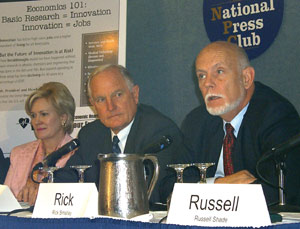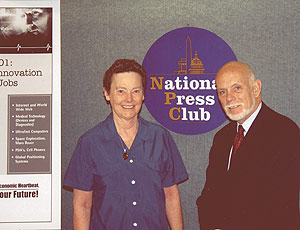  (Top photo): Richard Smalley speaks at the press conference announcing the advocacy campaign, while Craig Barrett of Intel and Deborah Wince-Smith of the Council on Competitiveness look on. (Bottom photo): APS President Helen Quinn with Richard Smalley at the press conference. |
Targeted at policy makers and the general public, the initiative will seek to reverse a decline in federal investment in basic research in the physical sciences and engineering through paid advertising and traditional lobbying and outreach to policy makers on Capitol Hill.
The new initiative is sponsored by the Task Force on the Future of American Innovation, which includes the APS and 13 other organizations associated with business and academia. Specifically, the task force is calling on the federal government to grow the budgets of key research agencies by 10-12% per year over the next five to seven years. These agencies include the National Institute for Standards and Technology, the National Science Foundation, the Department of Energy's Department of Science, and the Department of Defense's Research Accounts.
Basic research in the US over the last few decades has led to breakthrough technologies that havespawned entirely new industries. Notable examples include lasers, the integrated circuit, fiber optics, the Internet, and global imaging systems.
Such innovations in turn create jobs; the semiconductor industry alone has created 226,000 jobs with worldwide sales of $166 billion. Basic research at American universities has created 4,000 spin-off companies with an estimated 1.1 million employees and annual worldwide sales of $232 billion. And according to Robert Shaw, a Nobel laureate in economics, at least 50% of the nation's economic growth over the last 50 years has come from technological innovation.
Yet US federal investment in basic research continues to decline. While the GDP nearly doubled from $6 trillion in 1980 to $12 trillion today, federal investment in R&D in the physical and mathematical sciences and engineering plummeted 37%. President Bush's FY05 budget request continues the trend of previous administrations. The overall research budget would be down 1.8%, apart from a 0.6% increase for the Department of Health and Human Services. Two days after the announcement, the American Association for the Advancement of Science issued an analysis showing that the proposed Bush Administration's budget for the next five years would cut funding for basic research at 21 of 24 federal agencies.
At the press conference, Deborah Wince-Smith, president of the Council on Competitiveness, said that America's technological leadership faces greater competition from abroad as developing economies increase the number of PhDs in engineering and physical sciences and create new incentives for scientists and engineers to work outside the US. Other nations are rapidly replicating the structural advantages that historically have made the US the center of innovation: investing in education and job skills; building modern network infrastructures; financing new ventures; and opening their markets to global trade.
As a result, the US is fast approaching a "tipping point" at which 30 years of declining or flat federal research could have dire consequences for scientific discovery and innovation. "These changes demand that we rethink our approach to innovation," said Wince-Smith. "We need to reevaluate the policies, programs and institutes that were designed for a world in which innovation was linear and US leadership was unrivaled. In today's global marketplace, innovation is essential for economic security and American prosperity."
Hence the launch of the advocacy campaign, whose primary message is, "Don't flatline our innovation future by underfunding basic and applied research," according to Craig Barrett, CEO of Intel Corporation and chairman of the Computer Systems Policy Project. "We can choose to continue to invest in the industries of the 19th century and allow innovation to atrophy, or we can build on our past strengths and go forward to maintain our competitiveness."
Barrett pointed out that while the government has focused increasingly on the growing problem of outsourcing in industry, there has been almost no corresponding discussion regarding funding of basic research. Asked whether perhaps industry could pick up the slack, Barrett said that Intel alone spends $5 billion on product development R&D—more than the entire US government spends on basic research—and also spends an additional $100 million on research and education.
"America's universities and their researchers are the world's most prolific engines of innovation," said Nils Hasselmo, president of the Association of American Universities. "Investments in university research make America work and are vital to our security. They also provide indispensable hands-on research opportunities for the scientists of tomorrow. We understand current federal budget restraints. But research is the foundation of future economic growth and security."
Richard Smalley, a professor at Rice University and winner of the 1996 Nobel Prize in Chemistry for the discovery of buckyballs, reiterated Hasselmo's comments about the importance of universities to innovation, noting that his own field of buckyballs and carbon nanotubes has propelled the development of nanotechnology. Smalley himself cofounded Carbon Nanotechnolo-gies Inc. in 2000. "Our work-force is not flatlining, it's in decay. The US has been on a downward slide in supporting physical sciences and engineering for more than a decade," he said. "We've been living off the successes of the past. If we don't change course, we will leave our children a very poor legacy."
In addition to the APS, the current members of the Task Force on the Future of American Innovation include the American Chemical Society, the Alliance for Science & Technology Research in America (ASTRA), the Computer Systems Policy Project, the Council on Competitiveness, Intel Corporation, Hewlett Packard, IBM, the National Association of Manufacturers, the Science Coalition, the Semiconductor Industry Association, and Texas Instruments.
©1995 - 2024, AMERICAN PHYSICAL SOCIETY
APS encourages the redistribution of the materials included in this newspaper provided that attribution to the source is noted and the materials are not truncated or changed.
Associate Editor: Jennifer Ouellette
June 2004 (Volume 13, Number 6)
Articles in this Issue

